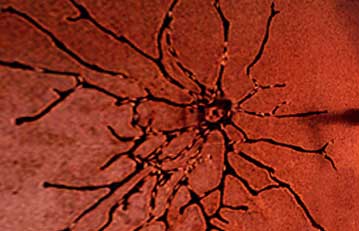Branching Termite Trails
As in many of the other experiments in this exhibit, the motion of the termites was restricted to ``two dimensions''. The sand is a thin layer between two plates of acrylic plastic. The spacing between the plates is 1/32-nd of an inch. This is the diameter of the largest part of these termites' bodies -- their heads. By making the spacing between the plates so tight, the termites must tunnel through the sand. They cannot walk on top of it. Roughly 150 termites were placed in the sand at the center. They crawled in through a hole in the plates. The sand is damp (we spray it with water), and so attractive to the termites as a place to search for food. This is referred to as ``foraging''. In the experiment in the picture, there is no food in the sand. As a result, the termites keep searching -- tunneling to find food. How would you describe this pattern? Is it ``fractal''? What is the role of chance and randomness in the pattern made by the termites? Is there an advantage to making long tunnels as opposed to clearing all the sand in a smaller range from the center?
|
 The branching pattern you see in this photograph
was made by termites in sand. The experiment was to see
the pattern of termite trails as they searched for food in
sand.
The branching pattern you see in this photograph
was made by termites in sand. The experiment was to see
the pattern of termite trails as they searched for food in
sand.